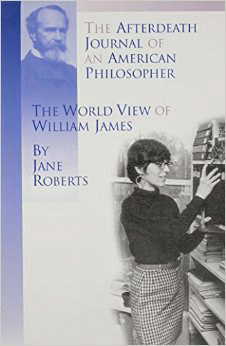Part of the Casswiki article series Books

The Afterdeath Journal of an American Philosopher: The View of William James is a book by Jane Roberts, first published in 1978. It consists of 16 chapters with an introduction and an epilogue.
Jane Roberts (1929 – 1984) was an American author and trance medium, who channeled a personality named “Seth”, which was published in her well-known works, the Seth Material.
This book reveals the author’s experiences with the “consciousness” of William James (1842 – 1910) and began taking James’ thoughts down on paper, which resulted in the completion of this book.
As Roberts writes in her Introduction on James:[1]
Then begins a fascinating discussion of his own experiences of life after death. Some passages in particular are full of humor and brilliance as James, the psychologist and philosopher, finds himself in a “school for philosophers” where he is definitely a junior member. In any case, here we see a definite personality, with his own interests and characteristics, moving from one level of reality to another. As, someday, all of us will.
I felt for James, and for myself, as I took down his description of the doubts, hopes, and bouts of melancholy that had characterized his life. It was impossible not to think of all such people, caught between faith and doubt, inner and outer experience - impossible not to identify with James’ own strongly conflicting ideas about humanity. Yet it was James’ “knowing light” and “atmospheric presence” encountered after death that most captivated - and comforted - me; his “divine psychology” and his intent to share his new knowledge, to teach as he learns.
As he learns? Did I suppose that a William James, a discarnate person, was sitting at a celestial desk somewhere, dictating through mentally sophisticated Dictaphone equipment - namely me? No, no, no. There are places in the manuscript where James describes his part in our rather bizarre arrangement, and there were several instances where I was so caught up in his emotions that for a moment his purposes merged with mine, or mine with his, so that the two of us spoke at once - synchronized, united, each from our own positions in time and space.
This book doesn’t involve any literary sense, but a stance taken by consciousness itself; it’s not a communication from William James in the conventionally understood manner of mediums and spirits, but a situation in which one consciousness takes the stance of another and views reality from that standpoint.
Chapters one through sixteen are expressed in James’ words. He begin with a look of himself as he was in life from his new profound “mature” perspective, and comparing this perspective as if one would as an adult with a perspective of a child (as he was on Earth). Then, he expanded his thoughts on the 19th century climate: politically, socially, psychologically, religiously and spiritually.
The topics in this book, regardless of the source, are thought-provoking and educational.
See also
- Jane Roberts
- William James
- Channeling and channeled material
References
- ↑ Roberts, Jane. The Afterdeath Journal of an American Philosopher: The View of William James, p. 14-15. Manhasset: New Awareness Network, Inc., 2001.
